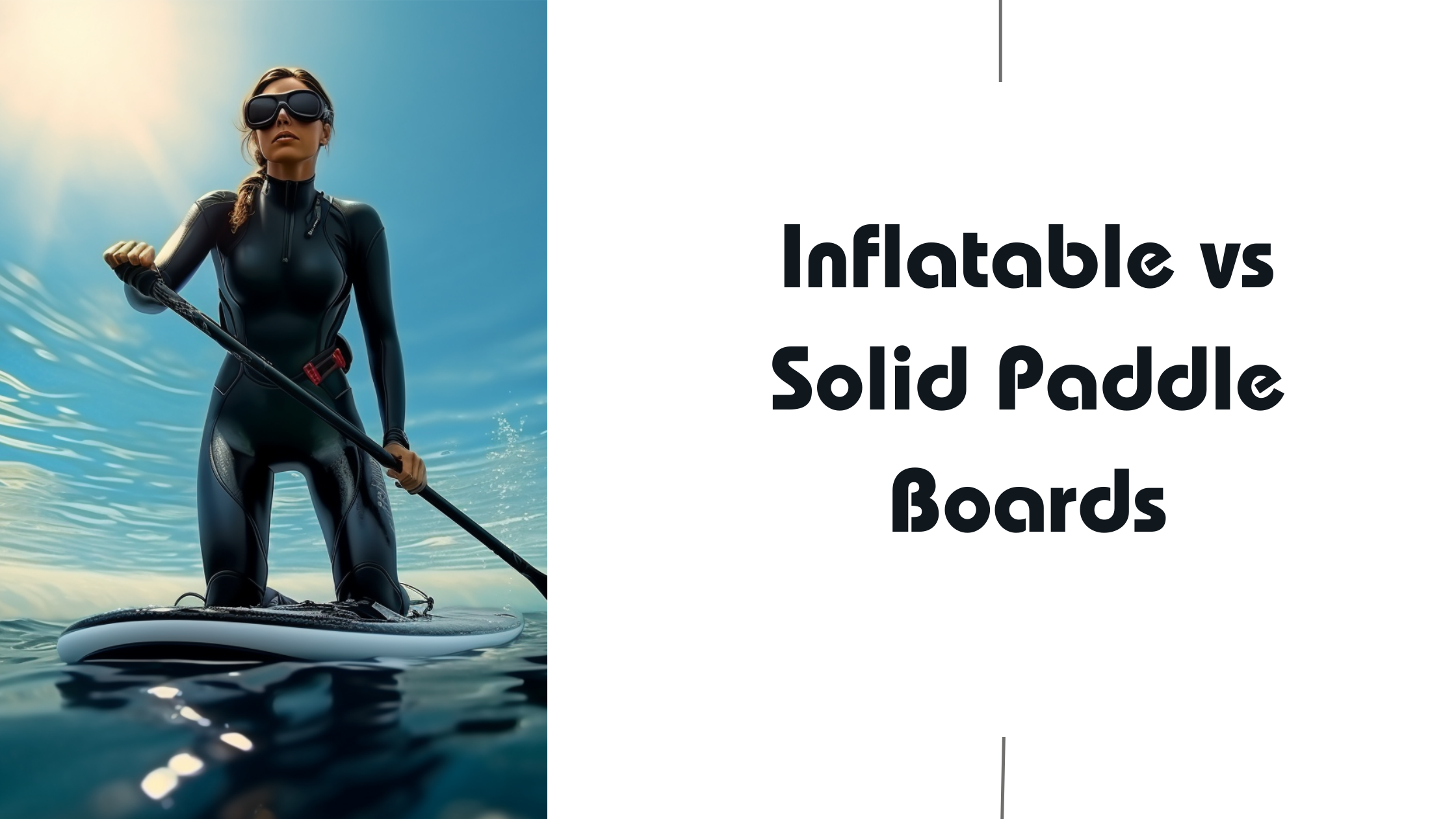Choosing the right board can be a daunting task for beginners.
Inflatable paddle boards and solid boards, the two prominent types, each have their own unique features and advantages.
Here, we will delve into the fascinating debate of inflatable vs. solid paddle boards, unraveling the strengths, weaknesses, and suitability of each type. This comprehensive guide will equip you with the knowledge you need to make an informed decision, whether you’re a seasoned paddleboarder or a novice.
Contents
- 1 What is an inflatable paddle board?
- 2 How durable is a solid paddle board?
- 3 Which is more portable, inflatable or solid?
- 4 What is the performance difference between the two?
- 5 Are inflatable paddle boards good for beginners?
- 6 How to maintain a solid paddle board?
- 7 What are the storage requirements for inflatable paddle boards?
- 8 Concluding Thoughts: Inflatable Paddle Board vs Solid
What is an inflatable paddle board?
An inflatable paddle board is a type of stand-up paddleboard (SUP) that is inflated with air to achieve its rigid structure. They are typically made of strong, durable PVC material with drop-stitch construction that allows the board to maintain a flat shape when fully inflated.

Unlike their solid counterparts, inflatable paddle boards can be deflated, rolled up, and easily stored or transported, making them a popular choice for those with limited storage space or those who enjoy paddleboarding while traveling. They are also generally more forgiving when it comes to bumps and collisions, which can be beneficial for beginners or those paddling in rocky areas.
However, inflatable paddle boards may not provide the same level of performance as solid boards in terms of speed and maneuverability. This is due to the slight flex that inflatable boards can have, especially in rougher water conditions.
Inflatable paddle boards vs solid boards is a common debate among paddleboard enthusiasts. While the choice ultimately depends on individual preferences and needs, it is important to consider factors such as storage, transport, durability, and performance when making a decision.
- Storage: Inflatable paddle boards can be deflated and stored in small spaces, while solid boards require more storage space.
- Transport: Inflatable boards are lighter and easier to transport than solid boards.
- Durability: Inflatable boards are more resistant to dings and scratches, but solid boards can offer longer lifespan if properly cared for.
- Performance: Solid boards typically offer better performance in terms of speed and maneuverability, but inflatable boards can be more stable, especially for beginners.
How durable is a solid paddle board?
Solid paddle boards, often made from epoxy or fiberglass, are known for their exceptional durability. These boards can withstand rough conditions and are less likely to get punctured or damaged compared to inflatable paddle boards. However, if a solid paddle board does get damaged, the repairs can be more complex and expensive.
One of the major advantages of a solid paddle board over an inflatable one is its resistance to wear and tear. They can endure bumps and scrapes without deflating or losing their shape. This makes them an ideal choice for paddlers who often navigate rocky or debris-filled waters.
Solid paddle boards also offer a higher level of performance. They glide smoothly through the water, offer excellent stability, and provide a firm platform for paddlers. This makes them a preferred choice for professional paddlers and those who engage in paddle board racing or surfing.
However, it’s essential to note that while solid paddle boards are durable, they require proper care and maintenance to ensure their longevity. This includes regular cleaning, avoiding prolonged exposure to sunlight, and proper storage when not in use.
In comparison, inflatable paddle boards have their own set of advantages, such as portability and ease of storage. But when it comes to durability and performance, solid paddle boards often have the upper hand.
Which is more portable, inflatable or solid?
When it comes to portability, the inflatable paddle board often takes the win over its solid counterpart. Weighing significantly less, inflatable paddle boards are not only easier to carry around but also require less storage space. They can be deflated and packed into a backpack, making them perfect for those who enjoy paddle boarding in different locations.
On the other hand, solid paddle boards, while offering stability and performance, can be cumbersome to transport. They require a roof rack or a large vehicle for transportation, which can sometimes limit your paddle boarding adventures to nearby locations.
In terms of setup, inflatable paddle boards can be inflated and ready to use in a matter of minutes. The convenience of being able to deflate, pack, and carry your paddle board on your back cannot be understated, especially when faced with the prospect of hauling a solid board.
However, it’s important to note that the portability of an inflatable paddle board comes with a trade-off in performance. Solid paddle boards are often preferred by experienced paddle boarders due to their superior speed and maneuverability.
In conclusion, if portability is your main concern, an inflatable paddle board may be the best option. However, if you prioritize performance and don’t mind the extra effort in transportation, a solid paddle board might be the right choice.
What is the performance difference between the two?
When it comes to the performance of inflatable paddle boards versus solid ones, there are several factors to consider. Firstly, inflatable paddle boards are known for their portability and ease of storage. They can be deflated and fit into a backpack, making them suitable for travel.
On the other hand, solid paddle boards, also known as hard boards, are often more rigid and stable. They offer superior performance in terms of speed and maneuverability, especially in rough waters. This is because they have a hard surface that cuts through the water more efficiently.
However, inflatable paddle boards have improved significantly over the years. High-quality inflatable paddle boards can now compete with solid boards in terms of performance. They are constructed with durable materials and offer good stability and buoyancy, making them suitable for a variety of water conditions.
Moreover, the choice between an inflatable paddle board and a solid one can also depend on the paddler’s skill level. Beginners might find an inflatable board more forgiving, while experienced paddlers might prefer the performance and speed of a solid board.
In terms of maintenance, solid paddle boards require more care. They are prone to dings and scratches, which can affect their performance over time. In contrast, inflatable paddle boards are more durable and resistant to damage.
Lastly, the cost can also be a deciding factor. Inflatable paddle boards are generally more affordable than solid boards, making them a popular choice for those on a budget.
Are inflatable paddle boards good for beginners?
Absolutely! Inflatable paddle boards are an excellent choice for beginners. They are lightweight and easy to maneuver, which is essential for those just starting their paddle boarding journey. In contrast, solid paddle boards can be heavy and challenging to control, especially for novices.
Inflatable boards offer the advantage of portability. They can be deflated, rolled up, and transported in a backpack, making them perfect for those who enjoy exploring different bodies of water. On the other hand, solid boards require a roof rack for transport and ample storage space at home.
Another significant aspect is the durability. Inflatable paddle boards are made from tough PVC material and can withstand bumps and scrapes without getting damaged. This is not the case with solid boards, which can get scratched or dented upon impact.
In terms of stability, inflatable paddle boards tend to be wider and thicker, providing a stable platform for beginners to learn and balance. Solid boards, while also stable, require a bit more skill to balance on, especially in choppy water conditions.
The only area where solid boards outshine inflatable ones is performance. Solid boards glide faster and offer better control, but this difference is hardly noticeable for beginners. As your skills improve, you might want to upgrade to a solid board for better speed and maneuverability.
In summary, inflatable paddle boards are user-friendly, portable, durable, and stable, making them an ideal choice for beginners.
When it comes to affordability, the inflatable paddle board typically has the upper hand over the solid paddle board. Inflatable paddle boards are generally cheaper to manufacture, resulting in a lower retail price for consumers. They also come with the added benefit of being easier to store and transport, which can save on additional costs associated with board storage and transportation.
On the other hand, solid paddle boards, often crafted from high-quality materials like epoxy and fiberglass, tend to be more expensive. These boards are designed for performance and durability, which can justify their higher price tag. However, the initial cost is not the only factor to consider.
- Longevity: Solid paddle boards, if well-maintained, can last longer than their inflatable counterparts, potentially offering better value over time.
- Repair costs: In the event of damage, solid boards can be more costly to repair compared to inflatable boards.
- Resale value: Solid paddle boards usually retain their value better, making them a more viable option if you plan on selling the board in the future.
Therefore, while inflatable paddle boards may be more affordable upfront, the overall cost-effectiveness depends on several factors, including usage, maintenance, and future plans. It’s essential to consider these aspects when deciding between an inflatable paddle board vs solid.
How to maintain a solid paddle board?
Maintaining a solid paddle board can be a straightforward process if you follow some simple steps. First, always rinse your board with fresh water after each use. This helps remove any salt, sand, or other debris that could potentially damage the board’s surface.
Secondly, it’s essential to store your board in a cool, dry place out of direct sunlight. Unlike inflatable paddle boards, solid boards are more prone to damage from heat and UV rays. Therefore, using a board bag or cover can offer additional protection.
Thirdly, regular inspections of your board are crucial. Look for any signs of dings, cracks, or other damage that might need repair. If you spot any, it’s best to address these issues promptly to prevent further deterioration.
Lastly, remember to properly care for your paddle and leash. Just like your board, rinse these accessories with fresh water and store them in a cool, dry place.
Although solid paddle boards require a bit more maintenance compared to their inflatable counterparts, many enthusiasts prefer them for their performance and feel on the water. By adhering to these maintenance tips, you can prolong the life of your solid paddle board and continue to enjoy your time on the water.
What are the storage requirements for inflatable paddle boards?
Inflatable paddle boards are a popular choice due to their portability and ease of storage. Unlike solid paddle boards, they can be deflated, rolled up, and packed away in small spaces. This makes them ideal for those with limited storage options or those who enjoy traveling with their board.
When storing your inflatable paddle board, it’s important to keep it in a cool, dry place. Extreme temperatures can cause damage to the material, affecting its durability and performance. It’s also recommended to store the board partially inflated to retain its shape and prevent creases from forming.
Proper cleaning before storage is also crucial. Rinse it with fresh water after every use to remove salt, sand, and other debris. Allow it to dry completely before packing it away to prevent the growth of mold and mildew.
Here are some key storage tips for your inflatable paddle board:
- Store in a cool, dry place
- Keep partially inflated
- Clean and dry before storage
Remember, proper storage not only extends the lifespan of your inflatable paddle board but also ensures it remains in optimal condition for your next paddle boarding adventure. Comparatively, solid paddle boards require more storage space and careful handling to prevent dings and scratches. Hence, your choice between an inflatable paddle board vs solid may largely depend on your storage capabilities.
Concluding Thoughts: Inflatable Paddle Board vs Solid
In summary, both inflatable and solid paddle boards offer unique advantages. Inflatable paddle boards are ideal for beginners due to their stability and affordability. They are also highly portable and require less storage space, making them perfect for those with limited storage or those who frequently travel.
On the other hand, solid paddle boards are known for their durability and performance. They are excellent for those who are more experienced and require a board that can withstand rigorous use. However, they do require more maintenance and storage space compared to their inflatable counterparts.
Choosing between the two largely depends on your individual needs, budget, and lifestyle. If portability and affordability are your priority, an inflatable paddle board might be the best option for you. If performance and durability are more important, a solid paddle board might be a better choice.
Remember, the most important thing is to enjoy the experience of paddle boarding, whether you choose an inflatable or solid board.

